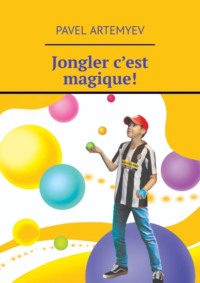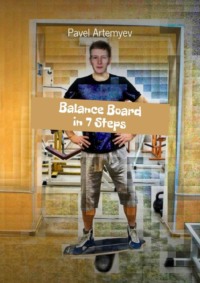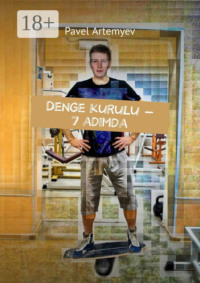
Полная версия
Juggling is Magic!

Juggling is Magic!
Pavel Artemyev
© Pavel Artemyev, 2023
ISBN 978-5-0059-5643-9
Created with Ridero smart publishing system
Pavel Artemyev
Juggling is Magic!
“To win,” first of all, you have to play.”
Albert Einstein
Word from the author
It just so happened that one of the heroes of my book learned to juggle. And then… Then demanding readers forced me to tackle the balls as well. Not to be too far behind his literary heroes. And so, collecting bit by bit heterogeneous information, rereading scientific articles and looking at the juggling technique, I realized with amazement that juggling is not just beautiful fun, but an extremely interesting and useful activity. Mental illness, dementia and depression, dysgraphia and dyslexia, problems with vision, with memory and motor skills of the hands, autism and daunism, the consequences of strokes and traumatic brain injuries are only a small part of those problems that can be treated with balls. If you want to improve your mood – grab the balls! If you want to warm up and have a sports training at work or right at home, juggling will help again! That is why hundreds and thousands of new clubs and clinics seriously practicing juggling appear in the world every year. Treatment with juggling is studied by doctors and has long taken note of scientific institutions. Extensive practice has confirmed that juggling is subject to any age – from 3—4 years old to 70—80.
Unfortunately, I myself took up the balls late (after 50 years), and yet, when after a few months I began to succeed, I realized that I would not limit myself to one skill. Juggling turned out to be magic, which I just had to share with others. So it came out.
I began to talk at meetings not only about my books, but also about juggling, about the close connection between these two arts. And when it turned out that there was no textbook on juggling for some reason (I did not find one), I wanted to fill this gap as well. So this book appeared, the purpose of which was – if not to teach, then at least to interest more people with this wonderful art. By that time, from my own experience and from the experience of my students, I managed to make sure: juggling is not something inaccessible: everything is in your hands! If you really want to master the art of juggling, do not doubt – you will succeed! Not after many mythical years, but quickly enough – after two or three months. And perhaps in a single week! The main thing here is not a factor in time, the main thing is that juggling is worth any effort! Since it is real magic affecting your health and mood, able to develop the brain and rejuvenate the body.
I’ll add: If you can’t wait to start learning, feel free to skip the first part of the book and start the second. Appetite comes with eating, and the theory won’t run away from us. It will be possible to familiarize yourself with the pauses between classes, having read about the history of juggling and the great benefits it brings.
And now we are charged with a fighting mood – and on the Way!
Part 1 History and Theory
“If you can train your arms and legs, then why can’t you train your brain?”
Grigory Perelman
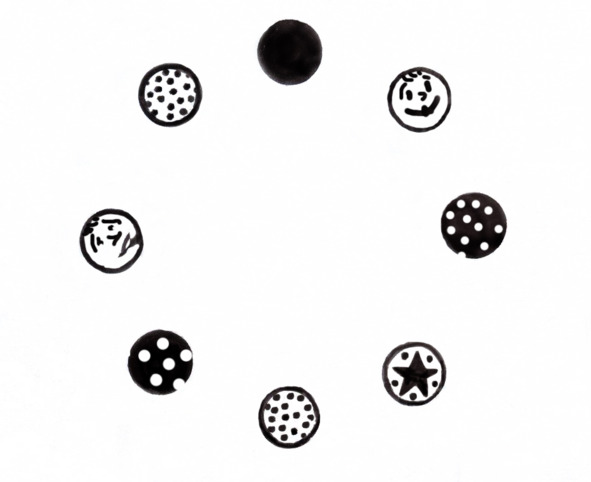
Chapter 1 Once upon a time…
Of course, the art of juggling was not born today. Virtuosos throwing all kinds of objects into the air can be seen on the walls of the oldest Egyptian buildings. In Chinese history, before battles, it was not uncommon for warriors on both sides to show their agility and power by raising heavy boulders and juggling edged weapons. There is a reference to the warrior Lan Tzu from the Song kingdom, who could juggle almost seven swords at the same time! If we recall today’s record of Fowler, who managed to master nine clubs, then the authenticity of historical evidence can be believed.
Well, first we will give a definition of what is understood by juggling:
so, juggling refers to the simultaneous manipulation of three or more objects, such as balls, sticks, rings, clubs and other objects.
Today it is the oldest genre of circus art and one of types of sport. In former times juggling was a prerogative of the vagrant troupes consisting of actors, acrobats and jugglers. These actors moved on open spaces of Europe and charmed a look of curious public. Well, and when from the middle of the eighteenth century in the large cities the first circuses began to open, jugglers, at last, found the haven. Approximately in the same decades their status as circus actors finally was fixed.
Those who are interested in more detailed history of juggling with pleasure I send to books Dominica Zhando “The history of world circus”, Aleksandra Kissa “If you are a juggler”, Karl Hynes Tsiten “Juggling art”, etc. At the same time I will notice: as it is sad, there isn’t a lot of books describing this most fascinating kind of activity. Especially when compared with the amount of literature devoted to theatre, ballet, painting or cinema. One of the professional jugglers with whom I spoke on this topic, suggested that this was partly due to the caste of the juggler’s profession. Any caste protects the secrets and therefore doesn’t hurry to share the mysteries of craft. Alchemists, smiths, doctors, conjurers, skillful soldiers – on the whole preferred to leave the main secrets at themselves that is quite explainable: it was their bread, their way of survival.
Nevertheless, already in the twentieth century there was a fundamental change of a situation. Juggling from caste occupation passed into the category more open and arts of a popular type. It should be added that in the world two new professional holidays appeared: The International Juggler’s Day celebrated on April 18 and the World Juggler’s Day celebrated on the third Saturday of June. Juggling was splashed out of borders of the circus arena, people began to juggle for a tone and own pleasure, to unite in juggling clubs and to hold competitions. Besides numerous clubs there were also such authoritative organizations as the International association of jugglers and the World Federation of Juggling. The set of colourful innovations was added to former classics of single juggling and cross over juggling (when several jugglers throw each other balls, maces and rings). This and popular nowadays contact juggling (rolling of spheres on a body and in palms), juggling from walls and a floor, power juggling (weights and kernels) and even team juggling by maces through a volleyball net.
Till certain time art of jugglers of “three-subject teachers” which also arose in Europe approximately in the thirties of our century stood a little alone. Having been born from saloon juggling, it kept many initial traditions, of which work with a various requisite was main. Instead of habitual rings, maces and balls jugglers “three-subject teachers” used habitual objects in use there are canes, cigars, snuffboxes, cylinders, saucers, billiard balls, etc. A difference in weight, in sizes and a form significantly complicated juggling process, but at the same time made a show more fascinating.
In the last decades of the twentieth century the world got acquainted also with more unusual types of juggling – such as: “Kendam”, “Fleyring”, “Diabolo”, “A stick of a devil” and so forth. To whom it is interesting, details and fascinating videos can be found without effort on the Internet. As far as I remember, personally I was struck most of all by “Joggling” – juggling with objects on the run. The combination of the words “juggling” and “jogging” just also formed the word “joggling”. American Bill Gidaz was the first, who had an idea to combine running with juggling, – and it was rather recently – in 1979. And also the first official record belonging to British Owen Mors was soon set. In 1988, juggling with five objects, he overcame a hundred-meter distance in 13.8 seconds!
Honestly I admit, these figures just shook me as I perfectly remembered that I even in the best years ran a hundred-meter race only in 13.2 seconds, losing almost ten meters to the friend to the athlete who had result 12.0. Yes, upon we overtook Owen Mors, but he at the same time also juggled!!! Yes not three balls, and at once five! However and that isn’t all. The record with the greatest possible quantity of objects on the run belongs to the Russian athlete Oleg Yakimuk who in 1990 ran 100 meters, juggling with seven objects! Well, and the record on the maximum distance belongs to Perry Romanovsky who in 2007, juggling with three objects, ran a 50-mile ultramarathon in 8 hours 23 minutes 52 seconds.
Impresses?
If not, I advise you – a little later, when you master the simplest “cascade” – walk with three fluttering balls along the park alley. Calm and slow. I think everything will become clear to you.
Of course, it is pointless to list all records. For all the short existence of this sport, there are a huge number of them. Virtuosos of all kinds of suits juggled and juggled for a while and a different number of objects, juggled in dance and on the run, on ropes and bicycles, alone and in whole teams. Bruce Sarafian of the United States achieved his highest score in 1995, juggling a dozen balls. Francois Chotard of France juggled nine balls with one hand. Even earlier, American Bobby May juggled 5 balls while standing on his head! Albert Lucas managed to cope with 13 rings, and Anthony Gatto juggled five clubs for 45 minutes…
Well, in addition to such famous names as Enrico Rastelli (an Italian born in Russia), David Kane, Michel Moshen, you can proudly remember numerous Russian juggling masters such as Sergei Ignatov, Alexander Kiss, Mikhail Rudenko, Alexander Frish, Evgeny Bilauer, Vladik Myagkostupov, Rudolf Levitsky et al.
Undoubtedly, in the history of working with balls you can find a lot of interesting pages and funny incidents, but the plus of today is that modern science has added to the sports component the discovery of the colossal benefit of juggling. Earlier generations could not even guess about this. And it was this circumstance that forced me to take up the pen, because I am convinced that, like writing, reading and physical education, juggling should also become an integral part of general education, helping millions of people to discover extraordinary abilities, increase immune and intellectual status.
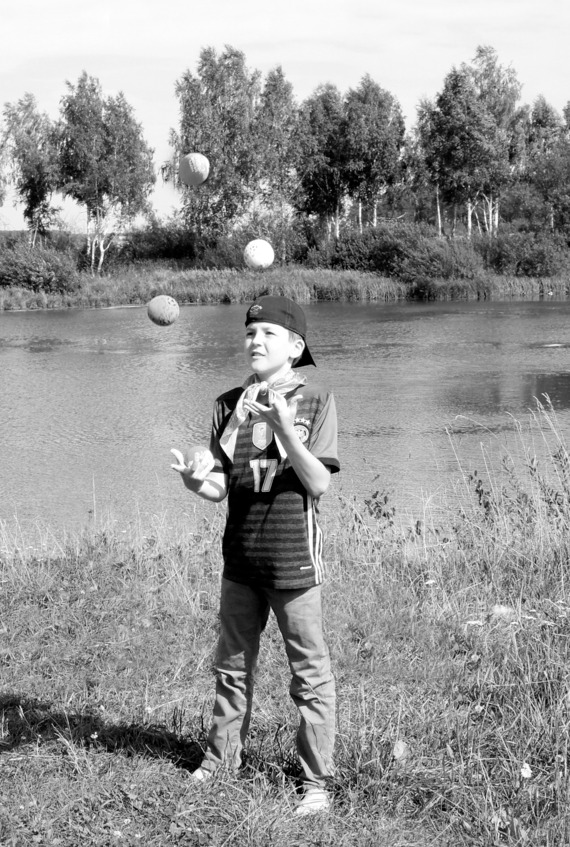
Chapter 2 Right and left hemispheres, great ambidextras
To begin with, let’s be clear: a person who has more command of the right hand is called dextral (right-handed), and the one who more often uses the left hand is called senestral (left-handed). But there are people who are equally adept at both hands. They are called the curly word “ambidextras.”
Speaking of the predominance of the right hand, it should be noted that this phenomenon is common, and there are approximately 85 to 92% of dextrals in the world. Accordingly, the remaining category of people can be attributed to lefties. This is 8—15%. Natural ambidextria – a phenomenon in which a person with the same confidence owns the right and left hand, is very rare.
It is so arranged by nature that the right hemisphere of the brain mainly controls the left hand, and the left hemisphere – the right. As a result, some one hemisphere dominates, and we, walking through life, thoughtlessly use mainly our predominant hand. Indeed, it is easier and more convenient. Only here the result of this inequality is that over the years the gap between the skills of the right and left hands increases more and more, and the potential of the unclaimed hemisphere becomes noticeably weaker.
In the future, in order not to get confused with the names of the hands, we will agree to use the terms: “starting-non-start” and “leading-slave.” In this case, the starting-leading hand will, of course, be right for right-handed and left for left-handed.
Continuing to talk about the current state of affairs, we recognize that we are rebuilding the world around us rather harshly – counting solely on the dominant hemisphere. The arrangement of steering columns in cars, door handles, pencil sharpeners, buttons on suits and trousers, playing cards, designs of electric kettles, scissors, canned knives and even an ordinary corkscrew – all this is aimed at the right-handed population. If you are left-handed and write like everyone else – from left to right, but with your left hand, then you do not see the written text. Moreover, you grease the palm of the not yet dried ink from the handle. Great? In my opinion, not so much.
Nevertheless, the practice of retraining left-handed people in the “right manner” until recently worked everywhere. Even in the case of not the most difficult activities, for a left-handed person, the indicated process was quite difficult. It is not for nothing that the corresponding term appeared among psychologists: “dextrastress” – that is, stress caused by violent and uncomfortable retraining into diametrically opposite programs. Today, the situation, fortunately, begins to change for the better, and most scientists tend to believe that right-handedness with left-handedness is not a pathology at all.
In this sense, juggling can be safely called a school of comfortable and democratic adaptation for both left-handed and right-handed people. There is no imposed dominance of any of the hemispheres. Juggling establishes complete equality between the right and left hemispheres of the brain. Everything that one hand knows how, over time, the other learns. Like neighbors on the school desk, hemispheres exchange all mastered secrets through the callous body in the brain.
So, teaching the starting hand to one trick or another, we are amazed to find that our wingman begins to do the same. Yes, this happens with some lag, but it also slowly masters the necessary technique.
As a result of training, we create symmetrical and quite equivalent neurochips, which just carry out the juggling process. This is a kind of collective parliament.
If someone believes that he lives well without all this canitel, you can conduct a small experiment. Take two leaflets and two pencils. Draw a circle with the right (starting) hand, repeat the same with the left on the adjacent sheet. It turned out pretty, didn’t it? And now in the same way draw a square, a triangle, a diamond, an eight. Write a short word – in printed letters, and then in capital. If your patience is enough for a whole line of words, touch your forehead. It is quite possible that by this time it will be covered with evaporation.
But!
Often changing your hands, you will notice how your driven (non-standard) hand will be more and more attentive to the work of the leading (starting) hand. In the most amazing way, she will adopt new skills, learn an unfamiliar! More precisely, neurons of the slave hemisphere of the brain will learn a new and unusual business. You will feel firsthand how your starting and leading hemisphere will help its neighbor, exhausted from unusual efforts. This is the same collegial work of the nascent DUAL-CORE and DUAL-HEMISPHERE processor! It is he who most clearly illustrates the advantage of the brain ambidextra.
By the way, the dominance of one hemisphere in the animal kingdom is not the most natural phenomenon. Accordingly, it does not paint people either. The conditions that we create for ourselves develop exclusively the starting hemisphere, and our second (driven) hemisphere practically sleeps. But it has its own unique features! But we do little to develop it, unwittingly contributing to increased “discrimination” between the right and left brains. As a result, even in situations where actions require increased control, our slave hemisphere is extremely ineffective. A paradoxical situation is created: the existing conditions of work and rest make both left-handers and right-handers suffer.
Therefore, there is no doubt that it is necessary to radically change the old approach to teaching children in preschool and school institutions. Without any stress, of course. The time has come for techniques that contribute to the natural and equal development of both hemispheres of our brain – with all their rich functionality, with increased memory and an increasing speed of thinking.
Learning should be built in such a way that the slave hemisphere of the brain becomes a full participant in solving life problems. A dual-core computer is more powerful and faster than a single-core computer, and something similar will happen to people. With Reading, Music and Juggling, we can develop both hemispheres of the brain equally. It sounds funny, but from a passive appendage – a half of your brain will turn into a faithful and full-fledged ally.
By the way, starting to juggle, I undertook to interview my acquaintances and very soon found out that many of them (usually the most wise and successful) – ALREADY own this art. By the way, my favorite writer Emil Azhar (aka Romain Gary) also juggled perfectly.
And since the names were used, I can’t resist and I will continue the lists, mentioning people who at different times also joined the ranks of ambidexters. This is natural left-hander Charlie Chaplin, who played the violin with his left hand, but wrote and painted with his right hand, this is Julius Caesar and Leonardo da Vinci, this is Nicolo Tesla and Luis Carroll. And also these are Pablo Picasso, Michelangelo Buonarroti, Auguste Picard, Shigeru Miyamoto, Alexander the Great, Benjamin Franklin, Paul McCartney, Vladimir Dahl and… Probably, you should not continue further, since the main conclusions, I think, you have already made.
And finally – an important stroke, which you should definitely know…
Yes, juggling promotes ambidextrium and initiates the creation of new neurochains. They are the ones who help us manage balls in the air. But these same neurocheps forming in the head are much more universal. And in the future they will be used not only for working with balls. The range of their capabilities is unimaginably wider, which helps jugglers (children and adults) make breakthroughs in other areas of life. In particular, this will be noticeable where spatial imagination is required, namely, in geometry and physics, in history and chemistry, in geography and in labor lessons. Hand motility, sense of rhythm, intuition, orientation and capabilities of the vestibular apparatus are an incomplete list of modes in which newly created neurochips will confidently help their owners. In many ways, this is what the growth of the IQ indicator is associated with. And this is no less than 4—6% (!). Tomography studies have finally confirmed an amazing phenomenon: in just 3—4 months, the brain of a juggling person adds 5—6% to the mass! And it’s not just a lot, it’s a fantastic lot! In essence, we become more memorable, smarter, smarter, which can only be surprised and rejoiced.
Chapter 3 Balls and our Fantasia
Once, fascinated by military equipment, I learned about the existence of combat complexes capable of detecting enemy batteries. Armed with computer processors, radar stations and acoustic direction finders, these formidable mechanisms in a matter of seconds along the trajectory of the arriving shells and the acoustic features of the breaks determined where the launch was made, from which guns or installations the enemy fired. Judging by the photos and videos, these are really serious machines operating according to their cunning programs, served by qualified personnel.
And what about military equipment, you ask? Yes, despite the fact that we are talking about really complex devices, about multi-stage algorithms developed by large teams of programmers. However, something similar is built in the heads of our neurons in the shortest possible time, as soon as we start juggling.
I will be distracted again and repeat the bearded thought: the human brain is unique. And the uniqueness of him is that throughout his life he does not lose the ability to improve. French writer Bernard Verbert said: “A person’s brain wears out when they don’t use it.” The discoveries of recent decades fully confirm this statement. If the nerve cell (neuron) is idle without work, it turns on the mechanism of self-liquidation.
Is it scary? And yes, and no.
The fact is that the total number of neurons in our country is really considerable (approximately 80—100 billion neurons). For comparison, in jellyfish – neurons only 800, in Drosophila – 250,000, in cockroach – 1,000,000, in rat – 200 million, in octopus – 300 million. An equal number of neurons are in a horse and a crow (just over a billion), in a macaque and a giraffe – 1.7 billion neurons each, in a bear – about 10 billion of them. But do not rush to proudly bend your chest, we are by no means champions. The same elephant has 257 billion neurons! And the brain of bottlenose dolphins is much larger than the human brain, and at the same time its neocortex (a new cerebral cortex responsible for higher nervous functions) is much more complex than that of humans. This, according to scientists, gives dolphins self-awareness and the ability to think. By the way, the number of convolutions in dolphins and whales is twice as large, and the language in complexity and linguistic reserve is quite comparable to the human one: 8,000 words in dolphins, and 14,000 in the average person! Agree, not so impressive a difference.
But perhaps it is worth taking a break from the numbers. Moreover, there is still enough mystery and fog in this area. It is now more important for us to understand that we use our seemingly quite promising brain apparatus extremely inefficiently. Actually, one of the hypotheses just claims that human old age comes so early precisely because of the idleness of our brain. And if with the end of schools and institutes, studies for us stop, then only we ourselves are guilty of this. Wise people learn throughout their lives! It is this process that supports our health like nothing else, significantly prolongs youth.
Any new problem tones the brain, and as a developmental task – juggling is ideal. We don’t just throw balls, our brains at this time work with shape, color, weight and variable movement. We are forced to build the most complex neurochips, and the software of these circuits will include all the laws of mechanics we know. Yes, we may not have enough knowledge of physics, do not know anything about ballistics, but the brain working with balls will quite independently fill these gaps. So it should be, since the balls fly not at random, but along predetermined trajectories, and we set these trajectories! Vertical, parabola, ellipse, eight – we chart the movement of the ball, absolutely knowing exactly what height it will fly to, where it will fall – and, therefore, to what place our palm should move in order to confidently catch the ball. In other words, at this time, the most complex software algorithms work in our head, and the neural circuits being built are quite comparable to modern processors.
A small illustration: one ball weighs 160 grams, the second – 170, and the third – 180. Let them throw a robot equipped with manipulators, and all three balls will fly in different orbits, slapping anywhere. To make the necessary correction, taking into account the difference in weight, you will need to make serious changes to the robot program. If the balls differ in color, and the robot tracks them visually, again it is impossible to do without additional programs. I was not too lazy and spent a couple of days trying to find something capable of juggling among digital mechanisms. Didn’t find it. More precisely, I found only an extremely primitive imitation of the simplest and disposable combinations. Of course, the success of scientific and technological progress is foolish to challenge. If humanity sets itself such a goal, the best engineers on the planet will certainly create a robot capable of juggling balls (maybe even clubs!). True, it will take both time and colossal costs. And this is not sarcasm, but just a statement of the amazing fact that our brains are much more powerful than existing computer systems. At least, he copes with the task of teaching juggling more than confidently.


